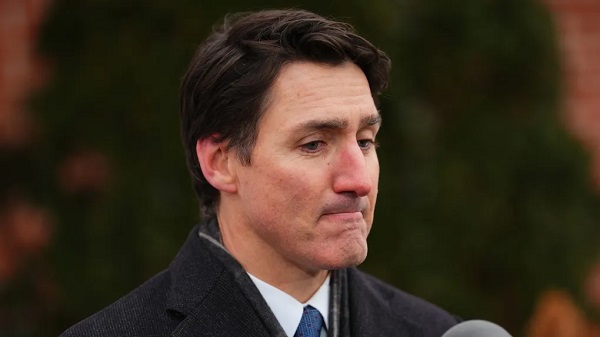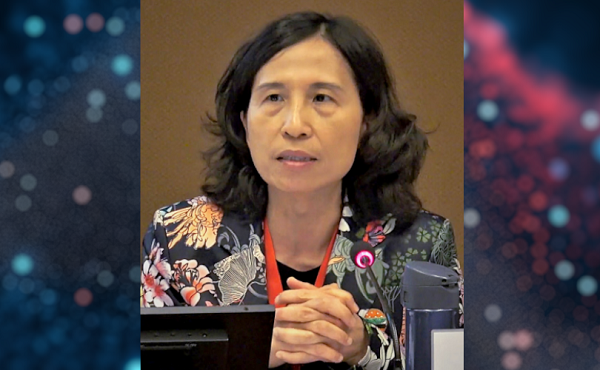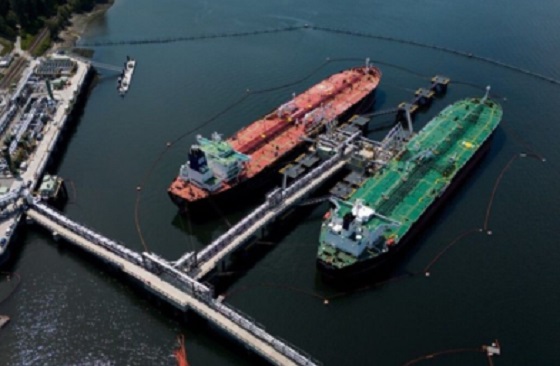National
After a decade spinning in a maelstrom, we’re headed straight into a hurricane.

To choose Trudeau’s successor as the Liberal Party’s new helmsperson, you need only be temporarily resident in Canada and 14 years old, and they don’t even check
Terry Glavin with The Real Story
Après nous, le déluge
It’s over. Well, sort of.
The Trudeau Liberals’ hegemonic hold on Canada’s political, cultural and economic life is now officially and formally winding down. Parliament has been prorogued until March 24, although it isn’t certain that Canada will have a new Parliament with a new prime minister even by June, when Canada is supposed to be hosting the G7, by which time the Liberals are expected to have a new leader too.
Who knows. We’ll get there. Justin Trudeau will be gone, but this is what you should bear in mind as Canada careens and lists and tumbles out of this mess.
The world’s first “postnational state” that Trudeau inaugurated in 2015, with the able assistance of Dominic Barton’s McKinsey & Company and all the resources the Canada-China Business Council threw at the project, was never intended to be some four-year thing to be evaluated by voters in the ordinary course of events.
It was built to be permanent. Its undoing will require one hell of an effort, and in the meantime Donald Trump’s inauguration – a $150 million extravaganza funded by Pfizer, OpenAI, Amazon, Meta and a constellation of cryptocurrency firms – is set for January 20.
That’s just two weeks away, and Trump has pledged to impose what would be a crippling 25 percent tariff on goods from Canada and Mexico “on Day 1” unless measures regarding flows of illegal migrants and drugs are somehow stopped.
We’ll see. The thing is, on Day 1, Canada’s federal government will be locked in the interregnum between the Trudeau epoch and Conservative leader Pierre Poilievre’s new “common sense” order. We’re sitting ducks.
What would a Conservative Great Leap Forward look like?
Poilievre deserves much credit for correctly diagnosing the several possibly fatal wounds the Justin Trudeau decade has inflicted on this country. About that, here’s something I found fascinating over the holiday hiaitus.
It would be worth your time to take in Poilievre’s conversation with Dark Web archdruid Jordan Peterson over the weekend, and then have a listen to the year-end remarks of the lonesome American socialist warlord Bernie Sanders.
Going by my own 90-minute encounter with Peterson a couple of weeks ago I can say that it isn’t easy to keep the conversation going exactly along the lines one might prefer. Not to criticize Peterson’s interviewing style but I can’t fault Poilievre for failing to get into any number of the the existential dysfunctions Canada is enduring.
Even so, Poilievre comes off more like an intelligent and slightly nerdy Canadian version of Bernie Sanders than the doofus Canadian iteration of Donald Trump that the Liberals and New Democrats have so strenously tried and failed to make him out to be.
Fun example: On Saturday, the NDP MP Peter Julian attributed Poilievre’s popularity to a “massive foreign interference strategy. . . the only reason Pierre Poilievre is leader of the Conservative Party right now.” He didn’t say this while drunk in a private conversation among fellow NDPers. Julian said this publicly, on the insufferable Elon Musk’s X, drawing on a thoroughly debunked conspiracy theory from last August.
At least the Conservatives are not crazy people
Today, the Feast of the Epiphany, is the anniversary of the Trumpist insurrection of January 6, 2021, an event that remains an open and profoundly embarrassing wound among Americans. I fully realize that there are some yobbish Putin fanciers at the outer fringes of Canada’s Conservative Party, but give me a break.
Can you imagine Canadian Conservatives storming Parliament Hill, smashing windows and breaking down doors and baying for blood? Of course you can’t. And you certainly can’t imagine Poilievre even coming close to countenancing such conduct, so don’t even try.
I don’t carry any water for Poilievre, but I am persuaded that he’s genuinely and sincerely concerned about the wretched state of affairs to which working-class Canadians have been reduced. Besides, Poilievre isn’t just the best alternative we’ve got. He’s the only alternative. Jagmeet Singh’s New Democrats are a caricature of the party they inherited, so here we are.
My National Post readers and this newsletter’s subscribers will know that I am not bubbling with optimism that Poilievre’s remedies can possibly heal what Canada has sustained. Without getting into all that, I’ve had my say, and while Poilievre’s overall analysis of the Trudeau era’s calamities is grounded in hard facts and driven by empathy, his “Axe the tax, Build the homes, Fix the budget, Stop the crime” remedies are woefully insufficient to the circumstances of the real world.
For starters, the immediate crisis a Poilievre government will face is the major cause of the economic dislocation we’re facing, and he’s been quiet about it: It’s not just that Canada’s housing and jobs economies have no room for roughly three million people in this country who are here on various kinds of “temporary” status. It’s more like 4.9 million people whose visas are going to expire before the end of this year.
No amount of tax-axing is going to deal with this, and you’d need something along the lines of a Mao-era Great Leap Forward to “build the homes” to house them all in residential markets that would be even vaguely affordable for most people. And to do that you’d have to tear down Canada’s cities and build a grim Leninplatz on top of each heap of rubble.
Here’s just one other little thing that could stand in the way of any effective legislative agenda that Poilievre might want to embark upon. Almost all the current occupants of the Upper Chamber are senators appointed by Justin Trudeau. So, that’ll be fun: on top of everything else, the prospect of forcing a constitutional crisis just to get anything done.
Not to be dreary, but about the brokenness, but see Notes on the Coming Disturbances, and a earlier assessment: Nearing Nine Years Since Year Zero, So there’s all that.
It’s not just Canada that’s broken. It’s the Liberal Party.
To build the new postnational state in place of what we’ve been badgered to understand as the genocidal old-stock white supremacist settler-state patriarchy that Trudeau so gallantly set out to save from itself, the Liberal Party had to be refashioned to serve as the conduit to Parliamentary power and privilege. See It’s 2025. Welcome to the Thunderdome.
Bear in mind that Justice Marie-Josée Hogue’s Public Inquiry into Foreign Interference in Federal Electoral Processes and Democratic Institutions is expected to issue its final report before the end of this month. The inquiry’s long-delayed and filibustered timetable had anticipated that Hogue’s proposed structural changes would be in place well before what was presumed to be an October 2025 federal election.
Here’s the thing about that. Never mind that owing to Team Trudeau’s rewriting of the party constitution we still don’t know who elected Trudeau to the leadership of the Liberal Party in the first place, and there’s been no inquiry into the massive infusions of weirdly coordinated Mandarin-bloc donations to Trudeau’s own riding association warchest in the aftermath of his 2015 capture of a Parliamentary majority.
See: Liberals are leaving an ungodly mess for Poilievre’s Conservatives to clean up; New report details just how easily China can mess with Canadian elections. In that piece, and in the Thunderdome newsletter, I refer at length to the findings in this in-depth analysis published by the Canadian International Council: Beyond general elections: How could foreign actors influence the prime ministership?
While all the talking-head punditry and chat-show panelists are preoccupied with speculation about just who might emerge as Justin Trudeau’s successor, here’s just one fact that has gone unnoticed. If you simply happen to be domiciled even temporarily in this country, you only have to be 14 years old to cast your vote for the next leader of the Liberal Party of Canada.
All for now.
Yes, this was a newsletter with no paywall.
To keep this project going, do please take up a paid subscription.
COVID-19
Top COVID doctor given one of Canada’s highest honors

From LifeSiteNews
Dr. Theresa Tam received the Order of Canada for her controversial COVID-19 response as the nation’s chief public health officer.
Canada’s former top medical advisor, known for her promotion of masking and COVID vaccines, has received one of Canada’s highest honors.
On June 30, Governor General Mary Simon awarded Dr. Theresa Tam, Canada’s former Chief Public Health Officer (CPHO), the Order of Canada award for her work implementing dangerous COVID regulations, including masking and experimental COVID shots.
“For decades, Theresa Tam has striven to advance global and national public health as a pediatric infectious disease specialist and public servant,” the press release read.
“Her tenure as Canada’s chief public health officer has been characterized by her commitment to health equity and highlighted by her leadership role in the country’s response to the COVID-19 pandemic,” it continued.
The award, given to Canadians who have made extraordinary contributions to the nation, is Canada’s second-highest civilian honor.
Tam’s reception of the award comes just weeks after she stepped down as CPHO, ending her eight-year tenure in the position.
In the early months of 2020, Tam became well-known by Canadians for leading the country’s response to the COVID “pandemic” and pushing arbitrary and dangerous regulations.
Initially, Tam assured Canadians that masking was unnecessary, ineffective, and could even pose health threats.
However, shortly after, Tam changed her policy, telling Canadians that they should even wear masks during sex, a practice which has not been proven to be effective in preventing the spread of COVID and can cause myriad health issues.
Additionally, Tam promoted experimental COVID vaccines for Canadians as young as six months old despite having no long-term studies on its effects and an extensive amount of research proving the dangers of the experimental COVID mRNA jabs that include heart damage and blood clots.
In 2022, after thousands of Canadians reported adverse effects from the vaccine, Tam announced that the federal government was reviewing all federal COVID vaccine mandates, claiming that Canada’s Public Health Agency has never outright endorsed mandatory vaccination.
Tam’s remarks come after more than 1,000 federal workers have been suspended without pay because they chose not to get the COVID jabs or disclose whether they had them per the Privacy Act.
The Order of Canada was also awarded to British Columbia Provincial Health Officer Bonnie Henry, who is known not only for her heavy-handed COVID response, but also for promoting drug use throughout the province.
In 2023, hundreds of British Columbia health care workers sued Henry for ongoing COVID shot mandates preventing them from working. Under Henry, vaccine passports were implemented which required residents to show digital proof of vaccination to enter gyms, restaurants, and other “non-essential” facilities.
Henry also pushed the experimental and dangerous vaccine on children as young as five, despite that fact that clinical trials would not be completed for another two years.
Additionally, in 2024, Henry recommended that British Columbia expand its “safe supply” program to legalize fentanyl and heroin, despite evidence that the program is not working and has worsened the provinces drug crises.
Energy
If Canada Wants to be the World’s Energy Partner, We Need to Act Like It

Photo by David Bloom / Postmedia file
From Energy Now
By Gary Mar
With the Trans Mountain Expansion online, we have new access to Pacific markets and Asia has responded, with China now a top buyer of Canadian crude.
The world is short on reliable energy and long on instability. Tankers edge through choke points like the Strait of Hormuz. Wars threaten pipelines and power grids. Markets flinch with every headline. As authoritarian regimes rattle sabres and weaponize supply chains, the global appetite for energy from stable, democratic, responsible producers has never been greater.
Canada checks every box: vast reserves, rigorous environmental standards, rule of law and a commitment to Indigenous partnership. We should be leading the race, but instead we’ve effectively tied our own shoelaces together.
In 2024, Canada set new records for oil production and exports. Alberta alone pumped nearly 1.5 billion barrels, a 4.5 per cent increase over 2023. With the Trans Mountain Expansion (TMX) online, we have new access to Pacific markets and Asia has responded, with China now a top buyer of Canadian crude.
The bad news is that we’re limiting where energy can leave the country. Bill C-48, the so-called tanker ban, prohibits tankers carrying over 12,500 tons of crude oil from stopping or unloading crude at ports or marine installations along B.C.’s northern coast. That includes Kitimat and Prince Rupert, two ports with strategic access to Indo-Pacific markets. Yes, we must do all we can to mitigate risks to Canada’s coastlines, but this should be balanced against a need to reduce our reliance on trade with the U.S. and increase our access to global markets.
Add to that the Impact Assessment Act (IAA) which was designed in part to shorten approval times and add certainty about how long the process would take. It has not had that effect and it’s scaring off investment. Business confidence in Canada has dropped to pandemic-era lows, due in part to unpredictable rules.
At a time when Canada is facing a modest recession and needs to attract private capital, we’ve made building trade infrastructure feel like trying to drive a snowplow through molasses.
What’s needed isn’t revolutionary, just practical. A start would be to maximize the amount of crude transported through the Trans Mountain Expansion pipeline, which ran at 77 per cent capacity in 2024. Under-utilization is attributed to a variety of factors, one of which is higher tolls being charged to producers.
Canada also needs to overhaul the IAA and create a review system that’s fast, clear and focused on accountability, not red tape. Investors need to know where the goalposts are. And, while we are making recommendations, strategic ports like Prince Rupert should be able to participate in global energy trade under the same high safety standards used elsewhere in Canada.
Canada needs a national approach to energy exporting. A 10-year projects and partnerships plan would give governments, Indigenous nations and industry a common direction. This could be coupled with the development of a category of “strategic export infrastructure” to prioritize trade-enabling projects and move them through approvals faster.
Of course, none of this can take place without bringing Indigenous partners into the planning process. A dedicated federal mechanism should be put in place to streamline and strengthen Indigenous consultation for major trade infrastructure, ensuring the process is both faster and fairer and that Indigenous equity options are built in from the start.
None of this is about blocking the energy transition. It’s about bridging it. Until we invent, build and scale the clean technologies of tomorrow, responsibly produced oil and gas will remain part of the mix. The only question is who will supply it.
Canada is the most stable of the world’s top oil producers, but we are a puzzle to the rest of the world, which doesn’t understand why we can’t get more of our oil and natural gas to market. In recent years, Norway and the U.S. have increased crude oil production. Notably, the U.S. also increased its natural gas exports through the construction of new LNG export terminals, which have helped supply European allies seeking to reduce their reliance on Russian natural gas.
Canada could be the bridge between demand and security, but if we want to be the world’s go-to energy partner, we need to act like it. That means building faster, regulating smarter and treating trade infrastructure like the strategic asset it is.
The world is watching. The opportunity is now. Let’s not waste it.
Gary Mar is president and CEO of the Canada West Foundation
-

 Business2 days ago
Business2 days agoRFK Jr. says Hep B vaccine is linked to 1,135% higher autism rate
-

 Business20 hours ago
Business20 hours agoWhy it’s time to repeal the oil tanker ban on B.C.’s north coast
-

 Censorship Industrial Complex2 days ago
Censorship Industrial Complex2 days agoGlobal media alliance colluded with foreign nations to crush free speech in America: House report
-

 Alberta14 hours ago
Alberta14 hours agoAlberta Provincial Police – New chief of Independent Agency Police Service
-

 Opinion11 hours ago
Opinion11 hours agoBlind to the Left: Canada’s Counter-Extremism Failure Leaves Neo-Marxist and Islamist Threats Unchecked
-

 Business2 days ago
Business2 days agoElon Musk slams Trump’s ‘Big Beautiful Bill,’ calls for new political party
-

 Alberta19 hours ago
Alberta19 hours agoPierre Poilievre – Per Capita, Hardisty, Alberta Is the Most Important Little Town In Canada
-

 COVID-1912 hours ago
COVID-1912 hours agoTop COVID doctor given one of Canada’s highest honors

